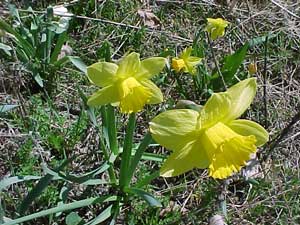 |
Among the most beloved spring bulbs, daffodils are easy to grow, require little care, have few pests, and tolerate a wide range of environmental conditions. They are one of the few bulbs that are not coveted by rodents.
Daffodils are members of a large and diverse family of hardy bulbs that bloom in the spring. They come in many flowers sizes and colors, but they all share a distinctive flower shape featuring a tubular center part protruding from a flat circle of petals. Those that have a cup or trumpet center that is as long as, or longer, than the petals are called trumpet narcissus. Others that have pronounced, yet somewhat smaller, center cups are called large trumpet daffodils. Both these types are the result of years of hybridization from wild European daffodils.
Daffodils grow as far north as upper New York State, the Great Lakes and along the east coast into New England (Zone 4). They are comfortable where winter temperatures seldom dip below -10° to -20°F. In warmer Southern climates, daffodil bulbs should be purchased pre-chilled.
Size: Daffodils range in height from 12 to 18 inches. The flower stem plus foliage produced by an individual bulb is about 6 inches wide. Dwarf trumpet varieties grow to only 5 or 6 inches tall and not quite as wide.
Foliage: Daffodil leaves are stiff, flattened, and straplike. From 12 to 18 inches long, and about 3/4 inch wide, they are bluish-green to green, and smooth. They emerge in the spring and die back in about 8 weeks, long after the flowers have faded.
Flowers: Daffodil flowers feature a long center cup, or "trumpet" which protrudes from a ring of 6 petals with pointed tips. Their colors range from white to yellow to orange to pink. Bicolor flowers have trumpets of one color and petals of another. Trumpets may also have frilly edges. Flowers are typically 1 to 3 inches long, 3 to 4 inches wide, one blooming at the top of each stem. Some are mildly fragrant. Trumpet type daffodils typically bloom in early April, ahead of most of their narcissus cousins.

